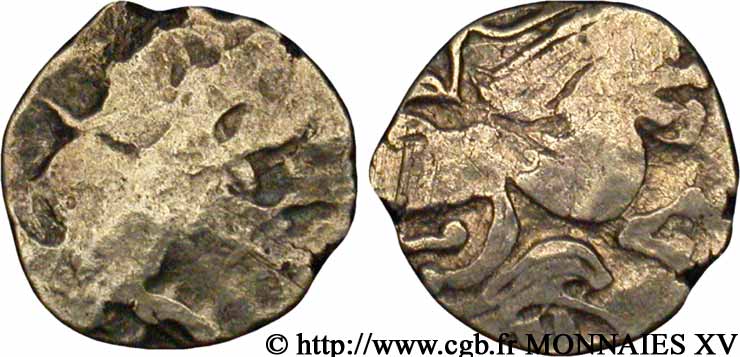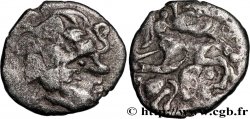v15_0757 - GALLIA - NAMNETES (Región de Nantes) Quart de statère à l'hippophore
MONNAIES 15 (2002)
Precio de inicio : 120.00 €
Valoración : 240.00 €
lote sin vender
Precio de inicio : 120.00 €
Valoración : 240.00 €
lote sin vender
Tipo : Quart de statère à l'hippophore
Fecha: c. 60-50 AC.
Nombre del taller / ciudad: Nantes (44)
Metal: electrum
Diámetro: 13,5 mm
Eje de acuñación: 3 h.
Peso: 1,60 g.
Grado de rareza: R1
Comentarios sobre el estado de conservación:
Monnaie complètement écrasée des deux côtés afin d’en faire disparaître les reliefs. Le revers se retrouve sur un flan légèrement bombé
N° en los catálogos de referencia :
Anverso
Titulatura del anverso: ANÉPIGRAPHE.
Descripción del anverso: Tête large et massive à droite, entourée de cordons perlés.
Reverso
Titulatura del reverso: ANÉPIGRAPHE.
Descripción del reverso: Cheval androcéphale galopant à droite conduit par un aurige étendant la main droite ; entre les pattes du cheval, hippophore.
Comentario
Ce type semble avoir été complètement usé artificiellement pour faire disparaître les motifs. Nous avons certainement affaire à un monnayage très tardif. La couleur jaune peut indiquer une présence d'or assez importante. L’appellation à l’hippophore vient du personnage qui est placé sous le cheval au revers (mot à mot celui qui porte le cheval où hippos se traduit par cheval et phoros par qui porte, en grec).
This type seems to have been completely artificially worn away to make the motifs disappear. We are certainly dealing with a very late coinage. The yellow color may indicate a fairly significant presence of gold. The name hippophora comes from the character placed under the horse on the reverse (literally the one who carries the horse where hippos translates as horse and phoros as who carries, in Greek)
This type seems to have been completely artificially worn away to make the motifs disappear. We are certainly dealing with a very late coinage. The yellow color may indicate a fairly significant presence of gold. The name hippophora comes from the character placed under the horse on the reverse (literally the one who carries the horse where hippos translates as horse and phoros as who carries, in Greek)








 Informar de un error
Informar de un error Imprimir la página
Imprimir la página Comparte mi selección
Comparte mi selección Haz una pregunta
Haz una pregunta Consignar / vender
Consignar / vender
 Descriptivo
Descriptivo









